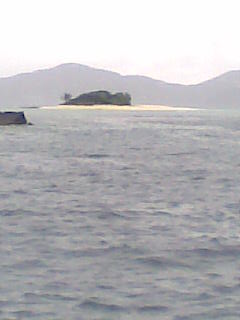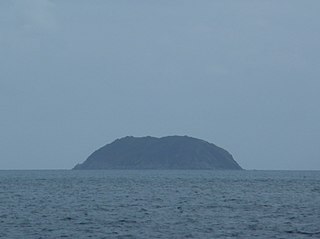Green Cay is an uninhabited island of the British Virgin Islands in the Caribbean. It sits between the eastern tip of Little Jost Van Dyke and Tortola. It is 14 acres (6 ha) in area.
Seal Island, Seal Islands and similar may refer to:
East Seal Dog is an uninhabited islet of the British Virgin Islands in the Caribbean. It is located in a smaller sub-group of islands referred to as the Dog Islands, or more commonly, "The Dogs". Other islets in The Dogs include Little Seal Dog Island, West Dog Island and George Dog Island, all of which are to the northwest of Virgin Gorda.

Cockroach Island is an uninhabited island of the British Virgin Islands in the Caribbean. It is located near North Sound, Virgin Gorda, amongst a collection of islands known as "The Dogs" or "The Dog Islands".

George Dog is an uninhabited island of the British Virgin Islands in the Caribbean. It is located in a smaller sub-group of islands referred to as "The Dogs" to the northwest of Virgin Gorda.
Great Thatch is an uninhabited island of the British Virgin Islands in the Caribbean. It is one of the westernmost islands in the Territory. It is believed to take its name from the famous pirate, Edward Teach, although there is little evidence Blackbeard ever sailed in the Virgin Islands.
Guana Island is an island of the British Virgin Islands (BVI) in the Caribbean. One of the few remaining privately owned islands in its part of the world, Guana has seven white powder-sand beaches and 850 acres (3.4 km2) of tropical forest, mountains, hills, and valleys. The island is mostly natural preserve and has a small resort.
Little Seal Dog Island is an uninhabited islet of the British Virgin Islands in the Caribbean. It is located in a smaller sub-group of islands referred to as the Dog Islands, or more commonly, "The Dogs". Other islets in The Dogs include Great Dog, East Seal Dog and George Dog, all of which are to the northwest of Virgin Gorda.

Little Camanoe is an uninhabited island of the British Virgin Islands in the Caribbean.
West Dog Island is an uninhabited islet of the British Virgin Islands in the Caribbean. It is located in a smaller sub-group of islands referred to as the Dog Islands, or more commonly, "The Dogs". Other islets in The Dogs include Little Seal Dog Island, East Seal Dog Island and George Dog Island, all of which are to the northwest of Virgin Gorda.
Little Thatch is a privately owned island of the British Virgin Islands in the Caribbean, upon which a resort has been built. The island is located less than 500 yards (460 m) from the western end of Tortola, and is less than 1 mile (1.6 km) away from Saint John, United States Virgin Islands. The island was sold by John and Jill Maynard in December 2014 to the owners of OtterBox, Curt and Nancy Richardson.
Sandy Cay is an uninhabited island of the British Virgin Islands in the Caribbean. It is located between Tortola and Jost Van Dyke. The island was owned by the Laurance Rockefeller Estate. On 1 May 2008, ownership of the island was transferred to the National Parks Trust of the Virgin Islands. In 2002, International NGO, Island Resources Foundation led a project to eradicate invasive black rats from the island.

Dog Islands are a small group of islets among the British Virgin Islands in the Caribbean.

Prickly Pear is an uninhabited island of the British Virgin Islands in the Caribbean. Even though the island doesn't have permanent residents, it has a beach bar and recreational water sports facility on it. It is located on the north side of North Sound, opposite Virgin Gorda.

Sandy Spit is an uninhabited islet of the British Virgin Islands in the Caribbean, sitting midway between Sandy Cay and Green Cay. It measures less than half an acre in size, and consists entirely of a ring of sandy beach surrounding light foliage. It has the appearance of a classic paradise "desert island" and has been photographed for use in print medium in a number of advertising campaigns. Sandy Spit is a popular stop for day and term boat charters from Tortola, St. Thomas, and St. John. There are no moorings, but the sandy bottom is suitable for anchoring.

Round Rock is an uninhabited island in the British Virgin Islands, to the south of Virgin Gorda, east of Ginger Island and close to Fallen Jerusalem Island.

The Tahitian Dog is an extinct breed of dog from Tahiti and the Society Islands. Similar to other strains of Polynesian dogs, it was introduced to the Society Islands and Tahiti by the ancestors of the Tahitian (Mā’ohi) people during their migrations to Polynesia. They were an essential part of traditional Tahitian society; their meat was included in Tahitian cuisine and other parts of the dog were used to make tools and ornamental clothing. Dogs were fed a vegetarian diet and served during feasts as a delicacy. European explorers were the first outsiders to observe and record their existence, and they were served to early explorers including Captain James Cook. The Tahitian Dog disappeared as a distinct breed after the introduction of foreign European dogs.

The Marquesan Dog or Marquesas Islands Dog is an extinct breed of dog from the Marquesas Islands. Similar to other strains of Polynesian dogs, it was introduced to the Marquesas by the ancestors of the Polynesian people during their migrations. Serving as a tribal totems and religious symbols, they were sometimes consumed as meat although less frequently than in other parts of the Pacific because of their scarcity. These native dogs are thought to have become extinct before the arrival of Europeans, who did not record their presence on the islands. Petroglyphic representations of dogs and the archaeological remains of dog bones and burials are the only evidence that the breed ever existed. Modern dog population on the island are the descendants of foreign breeds later reintroduced in the 19th century as companions for European settlers.










